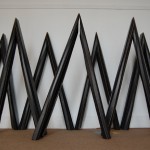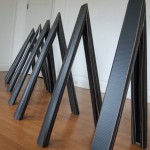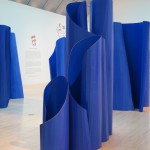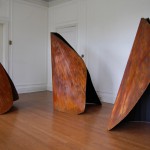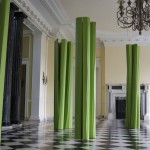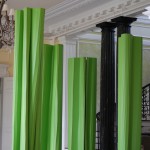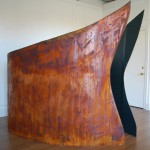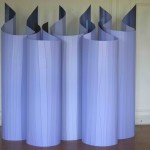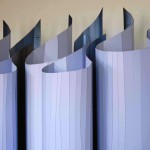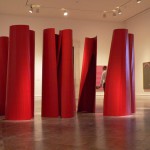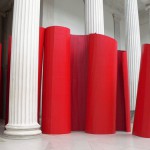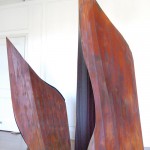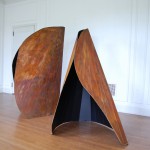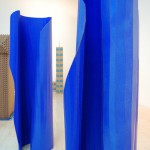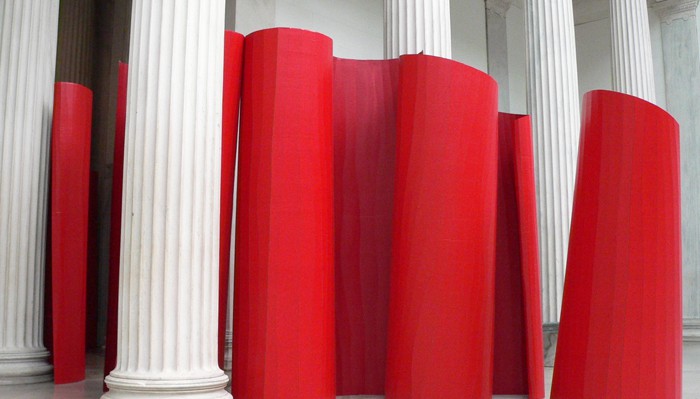
11.12.12 Featured Artist: Artemis Herber
- Artemis Herber, Barricades 2012
- Artemis Herber, Barricades 2012
- Artemis Herber, Coats, 2008
- Artemis Herber, Shelters, 2011
- Artemis Herber, Stems, 2010-2012
- Artemis Herber, Stems, 2010-2012
- Artemis Herber, Vessels, 2012
- Artemis Herber, Wings, 2012
- Artemis Herber, Wings, 2012
- Artemis Herber, Walls of Love, 2007
- Artemis Herber, Walls of Love, 2007
- Artemis Herber, Vessels, 2012
- Artemis Herber, Shelters, 2011
- Artemis Herber, Coats, 2008
Through my sculptures and installations, I explore ideas of how human beings live in spheres whether contained or imagined. Single segments of painted cardboard create safe, warm realms and remind us of our nature – pliable, easily formed, and changeable, thus simultaneously inclusive, exclusive and interactive. When those segments are grouped together, various dynamic relationships form. Each individual segment interacts and communicates with the others, showing the balance between stability and movement, equality and individuality, embracing and defending moments. The relationship between installation and site is energizing; the pieces can be configured endlessly, transforming the same space over and over again. An active relationship also develops between the installation and the viewer who walks through the surprise openings, obtaining new perspectives of the sculptural settings.
The material used is both visibly, imperfectly vulnerable and incredibly unpretentious, a medium that some may even consider “artless” and simple. Cardboard is a common material with uncommon versatility – mundane, industrial and cheap, yet interactive, global and irreplaceable. Cardboard protects and hides. It is warm, sturdy, dense and thick. Conversely, when I apply my technique of serial and constant scoring/carving, the vulnerability and impermanence of cardboard is unveiled. The cardboard segments are painted in vibrant, metallic or rusty colors. I transform the surface of the material into something that appears different (like metal, leather, or fabric), but the material maintains its reality through its corrugations, its inherent warm quality and its vulnerability and unpretentiousness. Because of their scale, color and surface reflection, they create a strong presence in their environment. With use of a “natural” handmade process, I reduce the product to a minimalist expression in color, form and material, thereby forming my own language. By repetition and grouping of individual objects, I achieve ever-changing “statement” creating poetry with the result.
My “Stems” series is based on the idea of recreating trees destroyed by environmental disasters (storms, bug pests, etc.) by copying the shape of stumps and reviving the trees. The shape of “Stems” is inspired by nature, with each individual segment of recyclable, sustainable corrugated cardboard creating a haven where visitors can take shelter. The original material of the trees is integrated and transformed at the same time, arousing memories of what was lost in real nature. The bright, fresh green colors inspire a dreamlike stroll through a vivid, optimistic environment, artificial but without denying our nature – a walk between illusion and reality.
“Shelters” reflects the idea of being visually and emotionally harbored, wrapped in basic tent-like cardboard formation associated with mantles or capes, providing a warm protective haven. Its elementary shape reminds us of a simple, natural and pristine way of life (like that of the Native Americans). In this sense it embodies the basic concepts of protection, retreat and introspection. The series also relates to a contemporary lifestyle of commuter travel, mobility and nomadism that brings us back to our basic need for a place to live, a place of safety, protection and orientation. Even further, it delves into the societal issues of poverty and homelessness and the actual use of cardboard as a warm protective shelter when other resources are not at hand. A single segment or a group of “Shelters” allows visitors to walk around in indirect ways exploring the space and the nature of the correlation to life: in the midst of an unstable economy and an environment plagued by manmade disasters, we cannot take a safe place to exist for granted.
My sculptural series “Barricades” explores how specifically shaped formations create an index of social conflict and how societies do (or do not) find solutions to those conflicts. “Barricades” embodies the concept of current unresolved global confrontations (Syria, Egypt, Greece) and centuries of historical construction representing a language of fear, defense and exclusion (Great Wall of China, Western Wall, Berlin Wall, Mexican/US border). I purposely juxtapose a common visual interpretation of “barricades” with the material I use, corrugated cardboard, which is sturdy but not lastingly durable, stable or resistant. Creating a visual barricade (which we suppose is a solid defense system between forces in conflict) out of cardboard ridicules the inherent meaning and converts the construction itself into an absurdity. The work conceptually questions systems of frontiers and barriers in social and political systems. As pre-fabricated pieces, “Barricades,” can be installed in varying formations, transforming any space as the barriers provoke visitors to stop, walk around and take detours. Those purposeful stops motivate to reflect on the specific site of the work. The pieces can be arranged in rows, circles, or even along permanent walls, each installation engendering different responses and creating different meanings. Minimal in color, material and formation, various groupings give rise to connotations of political topics, images of riots or reflections on totalitarian ideals implied in military parades. “Barricades” are the visual meeting point of two opposing sides, of unsolved conflicts between those longing for protection in unstable situations of social disparity. Even if built as protective boarders, barricades always imply aggression and thus serve as a provocation as well as a defense. In any installed formation,”Barricades” represent an index of society’s fragility, thin layers of civilization, the fine line between attack and defense of consciousness.
With their big, womb-like, rounded walls, “Vessels” evoke the idea of being harbored in a safe realm, separating exterior and environment with openings where viewers can walk in, through and around discovering different views and formations. In various groupings, they create interactions, floating dynamically, with boundaries constantly redefined. My inspiration came from how impressed I was by the giant vessels anchoring in Baltimore harbor, by the beautiful shape of the bows, sterns and keels. Many of those vessels sit at docks, shipyards or wharfs for repair. Others reside permanently, old rusty dinosaur, artifacts of global shipping and trade that define the city’s manufactured landscape and its economy. Paradoxically, my works are created from sustainable material, made of corrugated cardboard, a material which represents the market of global trade itself, now transformed and appearing rust-covered and decaying, denoting the temporal, fleeting character of our self-contained lives. I use paint to create a chemical process of rust or copper oxidation, which covers the cardboard, giving a natural look to artificial forms. It is this natural quality conveyed by the rusty surface that eliminates the perceptible distinction between found and newly created objects. In this sense, the existing boundary between nature (something naturally aged) and art is blurred. The process of covering an existing form replicates and changes that form, and it becomes an artifact and the icon of an artifact simultaneously. The outcome is a new sculpture (artifact of an artifact) that resembles the old one, but the new and old are not the same. “Vessels” become metaphors of an artistic artifact with connotations of a manufactured landscapes and urban life, referring to memories of our everyday life, creating a past that is already an ancient artifact of today.
Across culture and history, civilizations have built walls as defense systems, creating a global atmosphere of separation, isolation and, in consequence, alienation, all of which hinders us from being communicative, curious and social. “Walls of Love” represents a juxtaposed concept of simultaneously overcoming those inner and outer barriers, hurdles, and “walls”. In their message they are a peaceful and playful while at the same time obstructing and intrusive, reflecting the way humanity creates spaces and boundaries between cultures and nations. Thus with my work, just as in life, barriers or walls that seem to define our lives – appearing solid and sturdy – are transformed into a statement of impermanence. Seemingly rigid and immovable cardboard is revealed as fragile and flexible, even inviting and embracing when viewed from changing perspectives. The variation on groupings allows for surprise openings that make it possible to experience the installation on a personal level. In general, we associate “walls” with borders, and defense mechanisms, both on a personal and on a societal level. In contrast, my installation suggests a different approach: with their openings, the “Walls of Love” reference their osmotic character, showing a positive, living, warm climate where we remember our humanity.
“Coats” function as protective mantles covering our bodies, defending against elements, separating interior and environment. The “Coats” series reflects the correlative relationship between inner and outer worlds, place and space. Individual segments are sheltering womb-like spheres, where a human being can be contained. By using a mundane, industrial, sturdy cardboard instead of fabric, my “Coats” appear like walls or hardened curtains, defending and sheltering. At the same time their ultramarine/cobalt blue color attracts us and pulls us in, cocooning and conserving, bringing us quiet, tranquility and calm. Even though I choose to use darker shades of blue, both the ultramarine and cobalt blue evoke another look with their pureness and clarity, as they carry light and create a mystic sphere of reflection inside the sculptural shape. Within these juxtapositions “Coats” offers the playful option of life: they reflect the relationship between the inner and outer world, between the physical world and the world of mind and spirit, between being here and there, place and space. In various groupings, they create a warm climate of interaction, floating dynamically, with boundaries constantly redefined.
With my sculptural series “Wings,” I explore the question of how to merge artistic expression through painting with sculpture. Individual segments of “Wings” are minimalist constructions of concave and convex cardboard walls, extended on both sides with a higher density of front cuts, creating spatial sculptures, which extend their inhabited space With minimal use of color, tone and its gradations, the sculptural arrangement can appear scenic and picturesque and at the same time architectural, with the bold, womb-like segments emphasizing a sculptural construction. By combining perspectives, I create moments of illusion when elements of painting and sculpture reinforce each other and contradict each other by being unified in a simple sheet of corrugated cardboard.
Artemis Herber was born and educated in Germany. She completed her studies in Fine Arts and Arts Education at the University of Paderborn achieving scholarships and prizes. Herber has exhibited widely throughout the United States and on an international scale (Germany, Italy, Spain). Some recent exhibitions have included “Options 2011”, American University Museum at Katzen Art Center, Washington DC (2011), “Duets”, Delaware Center for the Contemporary Arts, Wilmington DE (2011), “Artefacts”, James Pierce Gallery, Baltimore MD (2010), and “Paderborner Kunstpreis 2010”, Kunstverein Paderborn, NRW, Germany (2010). The artist lives and works in Maryland.
Artist website: artemisherber.com
Tags: Journal